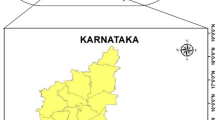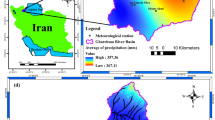Abstract
Accurately predicting groundwater level (GWL) fluctuations is one of the most important issues for managing groundwater resources. In this study, the feasibility of predicting weekly GWL fluctuations in a coastal aquifer using the wavelet-adaptive neuro-fuzzy inference system (WANFIS) was investigated. WANFIS was a conjunction model that combined discrete wavelet transform and adaptive neuro-fuzzy inference system (ANFIS). GWL data of two wells located in the coastal aquifer of eastern Laizhou bay, China, were used to establish WANFIS model. The performances of WANFIS model, along with ANFIS model, were assessed in terms of the following statistical indices, such as coefficient of correlation (R), root mean square error, and mean absolute relative error. Compared with the best ANFIS models, the best WANFIS model gave a better prediction. Moreover, it was found that wavelet transform positively affected the ANFIS’s predicting ability. In addition, the WANFIS model was also found to be superior to the best ANN model. This study indicated that WANFIS model was preferable and could be applied successfully due to its high accuracy and reliability for predicting GWL.










Similar content being viewed by others
References
Barlow PM (2003) Groundwater in freshwater-saltwater environments of the Atlantic coast. USGS Circular 1262. U.S. Geological Survey
Li FM (2005) Monitoring and numerical simulation of saltwater intrusion in the Eastern Coast of Laizhou Bay, China. Ph.D. dissertation, Ocean University of China (in Chinese)
Yoon H, Jun SC, Hyun Y, Bae GO, Lee KK (2011) A comparative study of artificial neural networks and support vector machines for predicting groundwater levels in a coastal aquifer. J Hydrol 396(1–2):128–138
Mohanty S, Jha MK, Kumar A, Sudheer KP (2010) Artificial neural network modeling for groundwater level forecasting in a River Island of Eastern India. Water Resour Manag 24(9):1845–1865
Kuo YM, Liu CW, Lin KH (2004) Evaluation of the ability of an artificial neural network model to assess the variation of groundwater quality in an area of blackfoot disease in Taiwan. Water Res 38(1):148–158
Firat M, Güngör M (2009) Monthly total sediment forecasting using adaptive neuro fuzzy inference system. Stoch Environ Res Risk Assess 24(2):259–270
Alvisi S, Franchini M (2011) Fuzzy neural networks for water level and discharge forecasting with uncertainty. Environ Modell Softw 26(4):523–537
Bayram A, Kankal M, Onsoy H (2012) Estimation of suspended sediment concentration from turbidity measurements using artificial neural networks. Environ Monit Assess 184(7):4355–4365
Coulibaly P, Anctil F, Aravena R, Bobee B (2001) Artificial neural network modeling of water table depth fluctuations. Water Resour Res 37(4):885–896
Lallahem S, Mania J, Hani A, Najjar Y (2005) On the use of neural networks to evaluate groundwater levels in fractured media. J Hydrol 307(1–4):92–111
Dash NB, Panda SN, Remesan R, Sahoo N (2010) Hybrid neural modeling for groundwater level prediction. Neural Comput Appl 19(8):1251–1263
Amir J, Navid J (2011) Groundwater modeling using hybrid of artificial neural network with genetic algorithm. Afr J Agric Res 6(26):5775–5784
Nayak PC, Rao YRS, Sudheer KP (2006) Groundwater level forecasting in a shallow aquifer using artificial neural network approach. Water Resour Manag 20(1):77–90
Krishna B, Rao YRS, Vijaya T (2008) Modelling groundwater levels in an urban coastal aquifer using artificial neural networks. Hydrol Process 22(8):1180–1188
Chang FJ, Chang YT (2006) Adaptive neuro-fuzzy inference system for prediction of water level in reservoir. Adv Water Resour 29(1):1–10
Shu C, Ouarda TBMJ (2008) Regional flood frequency analysis at ungauged sites using the adaptive neuro-fuzzy inference system. J Hydrol 349(1–2):31–43
Talei A, Chua LHC, Wong TSW (2010) Evaluation of rainfall and discharge inputs used by adaptive network-based fuzzy inference systems (ANFIS) in rainfall-runoff modeling. J Hydrol 391(3–4):248–262
Lohani AK, Kumar R, Singh RD (2012) Hydrological time series modeling: a comparison between adaptive neuro-fuzzy, neural network and autoregressive techniques. J Hydrol 442–443(6):23–35
Kholghi M, Hosseini SM (2008) Comparison of groundwater level estimation using neuro-fuzzy and ordinary kriging. Environ Monit Assess 14(6):729–737
Sreekanth PD, Sreedevi PD, Ahmed S, Geethanjali N (2010) Comparison of FFNN and ANFIS models for estimating groundwater level. Environ Earth Sci 62(6):1301–1310
Shiri J, Kişi Ö (2011) Comparison of genetic programming with neuro-fuzzy systems for predicting short-term water table depth fluctuations. Comput Geosci 37(10):1692–1701
Dabuechies I (1990) The wavelet transform, time-frequency localization and signal analysis. IEEE Trans Inf Theory 36(5):961–1005
Kim TW, Valdes JB (2003) Nonlinear model for drought forecasting based on a conjunction of wavelet transforms and neural networks. J Hydrol Eng 8(6):319–328
Adamowski JF (2008) Development of a short-term river flood forecasting method for snowmelt driven floods based on wavelet and cross-wavelet analysis. J Hydrol 353(3–4):247–266
Özger M, Mishra AK, Singh VP (2010) Scaling characteristics of precipitation data in conjunction with wavelet analysis. J Hydrol 395(3–4):279–288
Prokoph A, Adamowski J, Adamowski K (2012) Influence of the 11 year solar cycle on annual streamflow maxima in Southern Canada. J Hydrol 442–443(6):55–62
Nourani V, Komasi M, Mano A (2009) A multivariate ANN-wavelet approach for rainfall-runoff modeling. Water Resour Manag 23(14):2877–2894
Partal T (2009) River flow forecasting using different artificial neural network algorithms and wavelet transform. Can J Civil Eng 36(1):26–38
Rajaee T, Mirbagheri SA, Zounemat-Kermani M, Nourani V (2009) Daily suspended sediment concentration simulation using ANN and neuro-fuzzy models. Sci Total Environ 407(17):4916–4927
Adamowski J, Sun K (2010) Development of a coupled wavelet transform and neural network method for flow forecasting of non-perennial rivers in semi-arid watersheds. J Hydrol 390(1–2):85–91
Ramana RV, Krishna B, Kumar SR, Pandey NG (2013) Monthly rainfall prediction using wavelet neural network analysis. Water Resour Manag 27(10):3697–3711
Adamowski J, Chan HF (2011) A wavelet neural network conjunction model for groundwater level forecasting. J Hydrol 407(1–4):28–40
Jang JSR (1993) ANFIS: adaptive-network-based fuzzy inference system. IEEE Trans Syst Man Cybern 23(3):665–685
Jang JSR, Sun CT, Mizutani E (1997) Neuro-fuzzy and soft computing: a computational approach to learning and machine intelligence. Prentice-Hall, New Jersey
Drake JT (2000) Communications phase synchronization using the adaptive network fuzzy inference system. Ph.D. Thesis, New Mexico State University, Las Cruces, New Mexico, USA
Meyer Y (1993) Wavelets algorithms applications. Society for Industrial and Applied Mathematics, Philadelphia
Drago AF, Boxall SR (2002) Use of the wavelet transform on hydro-meteorological data. Phys Chem Earth 27(32–34):1387–1399
Mallat SG (1998) A wavelet tour of signal processing, 2nd edn. Academic Press, San Diego
Shiri J, Kisi O (2010) Short-term and long-term streamflow forecasting using a wavelet and neuro-fuzzy conjunction model. J Hydrol 394(3–4):486–493
Haykin S (1999) Neural networks: a comprehensive foundation, 2nd edn. Prentice-Hall, Englewood Cliffs
Fu MZ, Xu XSH, Cheng ZHB, Xu XW (1994) The seasonal desertification-climate environment in the coastal areas of the yellow sea and Bohai Sea. J Desert Res 14(1):31–40 (in Chinese)
Yin ZSH (1992) Study on seawater intrusion in coastal area in Laizhou. Marine Publishing House, Beijing (in Chinese)
Partal T, Kişi Ö (2007) Wavelet and neuro-fuzzy conjunction model for precipitation forecasting. J Hydrol 342(1–2):199–212
Nayak PC, Sudhee KP, Rangan DM, Ramasastri KS (2004) A neuro-fuzzy computing technique for modeling hydrological time series. J Hydrol 291(1–2):52–66
Vernieuwe H, Georgieva O, De Baets B, Pauwels VRN, Verhoest NEC, De Troch FP (2005) Comparison of data-driven Takagi-Sugeno models of rainfall- discharge dynamics. J Hydrol 302(1–4):173–186
Acknowledgments
This work was supported by the National Natural Science Foundation of China (41001013). The authors thank the anonymous reviewers for reading the manuscript and for the suggestions and critical comments.
Author information
Authors and Affiliations
Corresponding author
Rights and permissions
About this article
Cite this article
Wen, X., Feng, Q., Yu, H. et al. Wavelet and adaptive neuro-fuzzy inference system conjunction model for groundwater level predicting in a coastal aquifer. Neural Comput & Applic 26, 1203–1215 (2015). https://doi.org/10.1007/s00521-014-1794-7
Received:
Accepted:
Published:
Issue Date:
DOI: https://doi.org/10.1007/s00521-014-1794-7




